Horrific Inquiry: THE EVIL DEAD (1981)
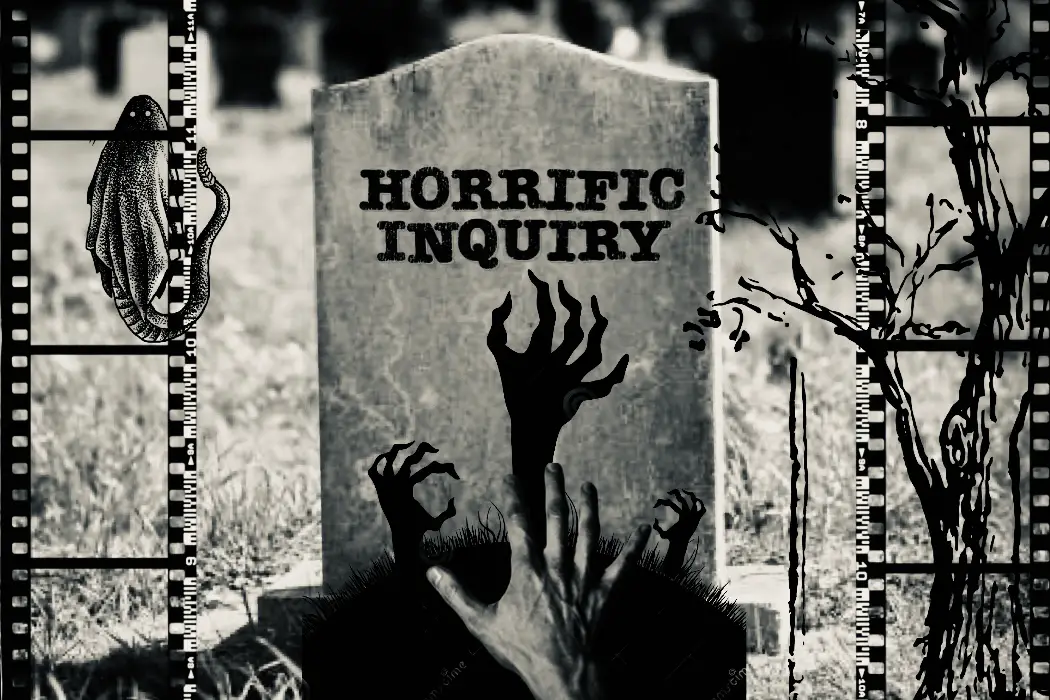
Stephanie Archer is 39 year old film fanatic living in…
Welcome back to the scariest, and at times goriest, column here at Film Inquiry: Horrific Inquiry. Twice a month, I will be tackling all things horror, bringing two films back into the spotlight to terrify and frighten once more. And occasionally looking at those that could have pushed the envelope further. Join us as we dive deep into the heart of horror, but warning, there will be spoilers.
“We’re going to get you.” – The Evil Dead
With the recent release of Netflix’s Evil Dead Rise, it struck a craving in me to finally see the Evil Dead movies. To be honest, I had never seen or even known much about the Evil Dead films, all too frequently confusing them with works from the zombie genre – especially that of George A. Romero. It was finally time to set the record straight and fill a gap in my cinematic horror education. And what a film I have been missing out on. Sam Raimi delivers a powerhouse of a horror film in The Evil Dead, leaning into all the senses to craft something truly terrifying. This film may be over forty years old, but its stomach-churning visuals and ear-piercing sound effects still reign supreme.
The Immediacy of Terror
The Evil Dead opens on a desolate swamp in the forest. The terror is delivered with a sense of urgency, the camera immediately launching into action as it swiftly sweeps over the forest floor, the chaotic sound of static carrying it. These sweeping low profile shots work well to create an uneasy feeling in the audience. As the tension builds, the scene transitions to a group of adults in a yellow car, a quietness settling in. While they are trying to find their way to a cabin they have rented, the scene transitions again to an oncoming truck before returning to the mystery in the forest. As the film cycles through these scenes in rapid succession, there is an intensity that grows as you wait for the convergence of disaster.
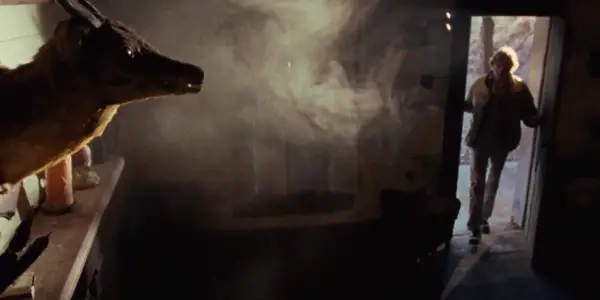
But disaster never comes, the cars just barely missing one another and the mystery lingering at the forest line. Yet, there is little reprieve given to the audience as the car must cross an old rickety bridge to make it to the driveway of the cabin. As it almost falls into the river below, once again the tension is driven high. Raimi is determined to keep the film’s intensity at a pulsating rate. While neither of these events results in devastation, the constant yo-yo-ing of tension refuses to let its audience return to a baseline of adrenaline. Raimi constantly maintains this pace of terror throughout the film, never giving enough time for the audience to recover, with new darkness always lurking in our blindside.
The Evil Dead wants you to look around every corner, to squint at every shadow – to feel the hairs rise on the back of your neck as your body feels there is someone behind you. And it manages to effectively craft this even in the face of passing time. As Scott (Richard DeManincor) enters the house, this is the first of many times audiences will find this feeling well grounded in the film, the various unique camera angles utilized by Raimi only heightening this effect.
What further heightens the effect is the pace of The Evil Dead, it is less concerned with spending time with its characters than grounding the film in horror. Cheryl (Ellen Sandweiss) is the first to be affected, her isolation from the group as she sketches the clock on the wall makes her an easy target. As the pendulum of the clock stops and the chimes blare, the wind brings the voice of evil. “Join us”, it calls, ominously caressing the night air. As Cheryl seems irked and unsure, her hand becomes possessed forcing her to draw a square with a face inside. Initially, I found myself distracted by its resemblance to SpongeBob, yet the tapping of the basement door pulled me right back. The Evil Dead has moments it begins to lose its grasp on its audience, but almost immediately corrects course.
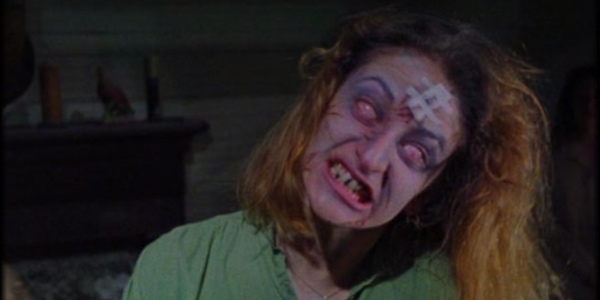
Audiences are not left long with Cheryl, a quick scene change bringing us back to the rest of the group and the next terror-building moment laying in wait. It comes with the same basement door flying open, revealing a vacant basement below. Scotty is the first down, followed by Ash (Bruce Campbell). The camera spans taking in the entire scope of the basement, our trained eyes waiting, expecting something to come out of the shadows. We know Scotty is hiding, waiting for the perfect opportunity to scare Ash. And while our predictions hold true, it is what they find in the shadows that truly sets the film into motion.
Awakening the Dead
While Ash’s walk through the basement showed the beginnings of the horror legend that would become Bruce Campbell, it is after the demonic awakening of the dead we see the true horror legend of writer and director Sam Raimi. While in the basement, Scotty and Ash find the quintessential Chekov gun, a creepy decked-out dagger, and the ritualistic book of skin – ie. the Book of the Dead. While we expect them to read the contents of the book sealing their fates, it is a recorded tape that becomes their undoing.
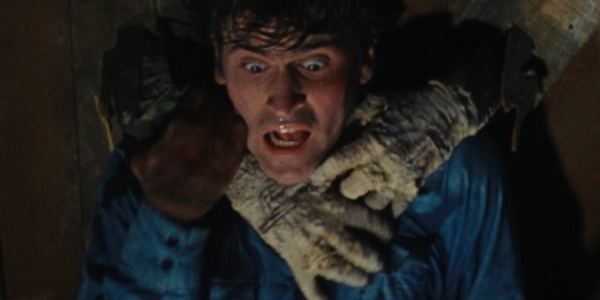
As the gang listens to the recording, the audience is brought outside to visually witness the evil they have unleashed. The ground rumbles and comes to life, mounds glowing red, lightning bolts brutally strike a tree and the moon fills with black smoke. It is beautifully constructed and lit to terrify. As the gang ends their exploratory evening, we are forced to feel the voyeuristic terror looking in, eventually settling on Cheryl and once again calling for her to “join us”.
The version I watched was listed as NC-17, leaving me to assume there was more graphic and more brutal gore and violence than the original film boasted. And what happens in the woods is just that. As the trees and vines come to life, they force Cheryl to the ground, literally penetrating the possession within her. It is brutal, violent and violating. And while Cheryl breaks free running back to the group, audiences are left with the visual spectacle they have just witnessed and the subsequent high pulsating chase of Cheryl as she flees for her life. You feel the terror and pain in her voice as she pleads for the group to leave, their reluctance once again isolating her.
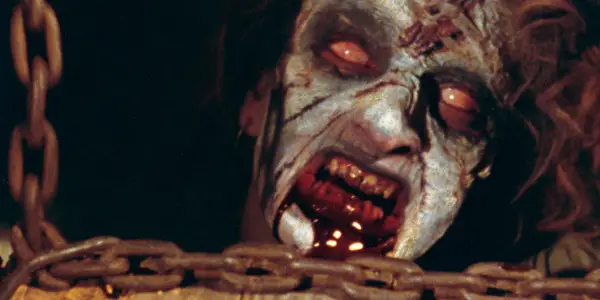
Throughout The Evil Dead, the composition and cinematography have delivered gorgeously horrific and haunting shots. As Ash agrees to take Cheryl away, the camera looks at Scotty, Shelly (Theresa Tilly) and Linda (Betsy Baker) in the door frame, the light coming from behind them, basking their faces in darkness. It is an ominous and foreboding shot, the three the next to fall victim to the possessive nature of the woods and the Book of the Dead. As Ash and Cheryl reach the bridge, the devastating realization that “it’s never going to let us leave” settling in, The Evil Dead delivers another stunning shot as the headlights are the last shining light for Cheryl, capturing her breakdown and final moments as a human.
Graphically Horrifying
The Evil Dead is graphic. Graphic, brutal and unrelenting. A huge fan of Hostel and Saw, I was surprised by how The Evil Dead made my stomach churn. From the moment Cheryl is revealed to have become possessed, The Evil Dead pushes hard until the very end. It is quick to develop its possession, Cheryl exhibiting strength, cunning and violence almost immediately. The speed and demonic baseline solidly gives the film a shocking turn of events.
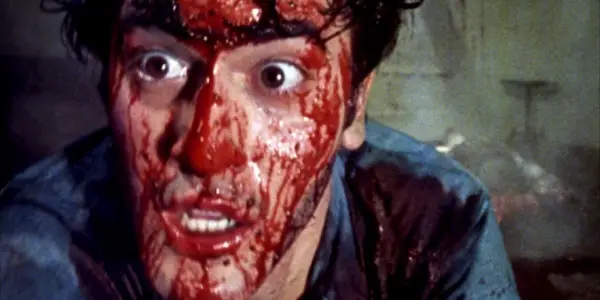
One by one, each Cheryl, Shelly, Linda and Scott fall prey to their own version of possession, proving that its initial baseline is further terrifying as it is not finite. Each time Cheryl is shown, her possession has further degraded her face, her strength growing. Having been trapped in the basement, with only a small gap to look through, she gives each horror composition depth, her face, actions and sounds constantly filling the background when a foreground presence is not necessary. Shelly, Scotty and Linda however each remain free and constantly a threat refusing to die. Ash’s confrontations with each deliver the best moments of gore.
Raimi is definitely not afraid of blood, the film literally gushing at any given moment. Whether it be from a pipe in the ceiling, the results of removed limbs, a stab in the back, shredding of Ash’s leg or a terrifying effect on the camera’s lens, blood is at the central core of The Evil Dead. But so are the puss and milky vomit like liquids that vacate the demons as they are injured – or subsequently die.
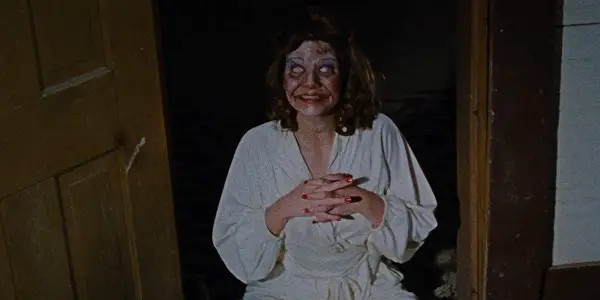
And it is not just in the various brutally violent attacks Ash endures, but in his final moment of success as well. As Ash manages to burn the book, ending the possession, the demons each go through an extremely horrific moment of decomposition that challenges the stomaches of viewers. In this moment, I couldn’t help but be fascinated by the deconstruction of each of the demons, the skill of makeup proving just as effective in death.
It’s all about what you hear.. and what you don’t
The Evil Dead displays exemplary craftsmanship as it plays a lot on the contrast of sounds. Each perspective goes from audibly chaotic static to a peaceful silence. Often times instantaneous, it is spine-chillingly unnerving. This is heard instantly in the film’s opening sequence between the quiet of the inside of the car to the loud chaos of the mystery moving through the woods. This plays out again in the voyeuristic moments of the evil peering into the cabin, the deafening static even louder when compared to the quiet tranquility inside.
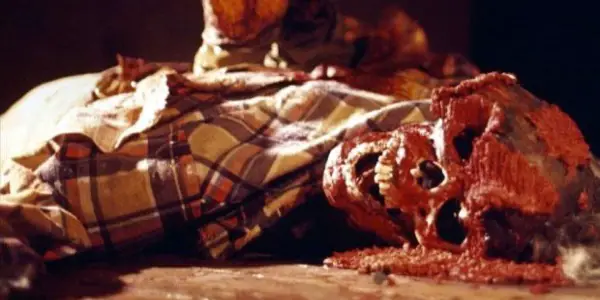
The absence of sound is terrifying too, giving each breakthrough of silence that much more of the potential to scare and delight. The quiet forest met with the snapping branches and the quietness of the cabin broken by the ticking of the clock are just some of the ways the tension is heightened in the film. As the car makes its way to the cabin, the sound of the chair swing hitting the house is repetitive and almost pulse-like. The loudness and the haunting echo of the chair in the silence of the forest speak to the isolation. As the chair suddenly stops, it is not only the abrupt ending of the movement but also the audio that gives us a sense of the supernatural. When the chair suddenly stops banging and the wind takes over, you realize just how isolating the sound of the chair truly was.
Every element of sound within the film is used as a tool to terrify rather than as an accompaniment to craft a mood. Sound is used with intent and precision, its execution undeniably a cinematic display of audible perfection. As Scotty enters the empty house, every sound is piercing in the silence of the woods and the cabin. The tapping on the basement door when Cheryl is haunted while drawing the clock, the snapping of the trees when Cheryl is in the woods prove sound effects dominate The Evil Dead.
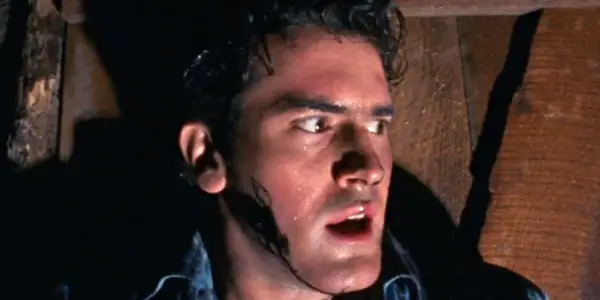
But is is not just the sound effects, the score commonly adopting a pulsating rhythm, many times isolating itself as heartbeat. Dialogue is executed to terrifying effect as well, the screeching of Shelly as she is stabbed in the back will send chills up your spine while Linda’s “we’re going to get you” will have your hair standing on end. As much as Raimi has you visually searching for evil in the darkness, he wants you to have a keen sense of sound, your body willing you to hear what you can not see – before it is too late.
Conclusion:
Honestly, I don’t know how I have missed this film over the years, and I couldn’t be happier to have filled this void in my horrific repertoire. Many films remain timeless, and The Evil Dead is no exception. It is brutally violent and unrelentingly gory, yet it is also the work of an artist with a passion for the craft. It has its horrifically gorgeous moments that compliment the most terrifying, merging every element of cinema to great effect.
Watch Evil Dead
Does content like this matter to you?
Become a Member and support film journalism. Unlock access to all of Film Inquiry`s great articles. Join a community of like-minded readers who are passionate about cinema - get access to our private members Network, give back to independent filmmakers, and more.













